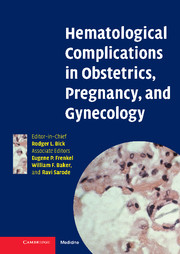Book contents
- Frontmatter
- Contents
- List of contributors
- Preface
- 1 Disseminated intravascular coagulation in obstetrics, pregnancy, and gynecology: Criteria for diagnosis and management
- 2 Recurrent miscarriage syndrome and infertility caused by blood coagulation protein/platelet defects
- 3 Von Willebrand disease and other bleeding disorders in obstetrics
- 4 Hemolytic disease of the fetus and newborn caused by ABO, Rhesus, and other blood group alloantibodies
- 5 Hereditary and acquired thrombophilia in pregnancy
- 6 Thromboprophylaxis and treatment of thrombosis in pregnancy
- 7 Diagnosis of deep vein thrombosis and pulmonary embolism in pregnancy
- 8 Hemorrhagic and thrombotic lesions of the placenta
- 9 Iron deficiency, folate, and vitamin B12 deficiency in pregnancy, obstetrics, and gynecology
- 10 Thrombosis prophylaxis and risk factors for thrombosis in gynecologic oncology
- 11 Low molecular weight heparins in pregnancy
- 12 Post partum hemorrhage: Prevention, diagnosis, and management
- 13 Hemoglobinopathies in pregnancy
- 14 Genetic counseling and prenatal diagnosis
- 15 Thrombocytopenia in pregnancy
- 16 Neonatal immune thrombocytopenias
- 17 The rational use of blood and its components in obstetrical and gynecological bleeding complications
- 18 Heparin-induced thrombocytopenia in pregnancy
- 19 Coagulation defects as a cause for menstrual disorders
- Index
- Plate section
- References
15 - Thrombocytopenia in pregnancy
Published online by Cambridge University Press: 01 February 2010
- Frontmatter
- Contents
- List of contributors
- Preface
- 1 Disseminated intravascular coagulation in obstetrics, pregnancy, and gynecology: Criteria for diagnosis and management
- 2 Recurrent miscarriage syndrome and infertility caused by blood coagulation protein/platelet defects
- 3 Von Willebrand disease and other bleeding disorders in obstetrics
- 4 Hemolytic disease of the fetus and newborn caused by ABO, Rhesus, and other blood group alloantibodies
- 5 Hereditary and acquired thrombophilia in pregnancy
- 6 Thromboprophylaxis and treatment of thrombosis in pregnancy
- 7 Diagnosis of deep vein thrombosis and pulmonary embolism in pregnancy
- 8 Hemorrhagic and thrombotic lesions of the placenta
- 9 Iron deficiency, folate, and vitamin B12 deficiency in pregnancy, obstetrics, and gynecology
- 10 Thrombosis prophylaxis and risk factors for thrombosis in gynecologic oncology
- 11 Low molecular weight heparins in pregnancy
- 12 Post partum hemorrhage: Prevention, diagnosis, and management
- 13 Hemoglobinopathies in pregnancy
- 14 Genetic counseling and prenatal diagnosis
- 15 Thrombocytopenia in pregnancy
- 16 Neonatal immune thrombocytopenias
- 17 The rational use of blood and its components in obstetrical and gynecological bleeding complications
- 18 Heparin-induced thrombocytopenia in pregnancy
- 19 Coagulation defects as a cause for menstrual disorders
- Index
- Plate section
- References
Summary
Thrombocytopenia is a common hematoloc1gical disorder that has classically been evaluated in an orderly clinical and laboratory approach. When thrombocytopenia is identified in the patient who is pregnant, important clinical differences and therapeutic implications exist when compared to the non-pregnant patient. These relate to the safety of the mother during pregnancy, viability of the fetus, the proper approach to parturition, and post-delivery care of the mother and the baby.
The recognition of thrombocytopenia is quite common in pregnancy, occurring in nearly 10% of patients. An unusual aspect of most of these events is that the majority are physiological. Thus the term “gestational thrombocytopenia” has been applied to this group of patients. This physiologic event must be differentiated from the less common, but clinically significant occurrence of a pathological mechanism for the thrombocytopenia. Such pathologic events are commonly associated with an evident clinical presentation and are potentially serious issues in the maintenance of the pregnancy and the health of the mother. In some circumstances, the thrombocytopenia is actually part of a more complex clinical disorder. The causes of thrombocytopenia in pregnancy are delineated in Table 15.1.
Gestational or physiological thrombocytopenia
Clearly, the most common cause of thrombocytopenia in pregnancy is a physiological event, since it is seen in 5 to 7% of all pregnancies, and actually accounts for more than 75% of all cases of thrombocytopenia during pregnancy.
- Type
- Chapter
- Information
- Publisher: Cambridge University PressPrint publication year: 2006



